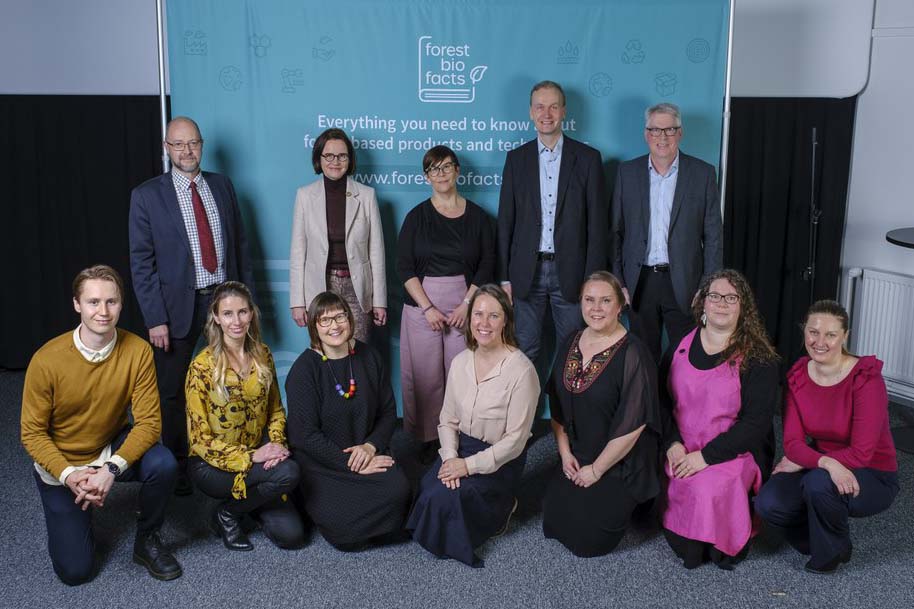150 professionals contributed to ForestBioFacts during the 3-year project. Editors Jouni Paltakari and Heli Kangas with Managing Director of Forest Products Engineers and publishing company Paperi ja Puu Ltd Antti Lindqvist and Chair of Forest Products Engineers Riikka Joukio and Chair of Paperi ja Puu Ltd Lauri Verkasalo in the upper row. Huge work was carried out by the working group in the row below: Valtteri Soilampi, Natalia Musina, Katriina Valkeapää, project manager Jenni Sievänen-Rahijärvi, Johanna Vainiomäki, Susanna Lähdesmäki and Victoria Lindqvist. Samuli Koivu is missing from the photo.
When the design process of a digital learning environment for forest bioeconomy started three years ago, no one knew how important online education would become at the completion of the project. The project, initiated by Forest Products Engineers and Paperi ja Puu Ltd, could not have had better timing.
“We happened to schedule our project perfectly as the radical changes in working methods and higher education studies mean that online learning materials are now in high demand,” says Communications and Marketing Manager Katriina Valkeapää from Forest Products Engineers.
ForestBioFacts consists of more than 1,500 articles and over 300 videos. The content is provided in English but the introduction has been produced in Finnish as well.
“The learning environment was designed to support the studies of higher education students as well as for professionals as an everyday tool. It offers quick solutions to challenges, new ideas for development and reliable fact-checking. The introduction also serves as a basic course on forest bioeconomy for upper secondary school students,” says Jenni Sievänen-Rahijärvi, Project Manager of ForestBioFacts.
The straightforward introduction is available to anyone free of charge and includes information on relevant education and training opportunities.
“We want to encourage young people to seek meaningful studies and work to ensure that we will be able to build a more sustainable world in the future,” says Valkeapää.
“It’ll be wonderful if young people get interested in the field and it will lead to us having skilled personnel in the future as well,” says Jenny Müller-Wahlman, Director of Innovation and R&D who represented Stora Enso in the project as a member of the steering group and the technical committee.
Update needs result in a new project
The project’s starting point was the 21-part series of books called Papermaking Science and Technology that once again suffered from expired information.
“Renewing a printed series of books every 10 years seemed like a bad plan. That’s why we decided to adopt a fully digital learning environment,” explains Sievänen-Rahijärvi.
The Board of Directors at Paper and Timber served as the owner of the project, and the practical execution was carried out by the Forest Products Engineers team. Antti Lindqvist, Managing Director of Forest Products Engineers and CEO of Paperi ja Puu Ltd, and Project Manager Sievänen-Rahijärvi cooperated in launching the enormous undertaking.
“The Board was tasked with monitoring the project’s progress according to plan, and we can now say everything went like clockwork,” says Chair Lauri Verkasalo.
The carton expert, working as a Development Manager in the research and product development department of Metsä Board, was also a member of the steering group.
While Aalto University played the key role in the university cooperation, all of the universities and higher education institutions offering relevant studies were invited to join the preliminary design and planning stage.
“This was our way of ensuring that the learning environment offers content suited to the study programmes of higher education institutions,” says Antti Lindqvist.
Illustrative videos
While the learning environment is based on updated or rewritten articles from the original series of books, it also features new topics, such as wood products, textile applications and bioenergy. The content covers the entire value chain, starting with forestry, and is divided into 16 themes edited by professors and specialists.
“The learning environment also includes a large amount of video materials. Thanks to interviews with experts and materials produced by businesses, the content is more tangible and illustrative than before,” says Jenni Sievänen-Rahijärvi.
“There are also videos of each editor, introducing their theme. In addition, we took a 360-degree video of an authentic factory enviroment that can be viewed with a VR headset,” says Forest Products Engineers’ Communications and Marketing Coordinator Johanna Vainiomäki, who played a vital role in both content production and user testing.
Each theme has its own colour and symbol which makes it easier to navigate on the course platform. The visuals were created by Graphic Designer Virpi Koljonen who also designed the look of Forest Products Engineers.
“I worked in close cooperation with the project team. My goal was to create a look that was timeless and accessible.”
Businesses join in
The business network of Forest Products Engineers made it easy to find partners for the project.
“The starting point was that partnership would benefit everyone. The businesses were involved in the design and planning stage to ensure that the content would genuinely be useful to them. All of the partners will automatically be made users of the learning environment,” says Antti Lindqvist.
“Updating and maintaining the learning materials is definitely an asset for us as well. It’s impossible to remember everything by heart, and digital materials make it easy to search for information. ForestBioFacts will see lots of use at Stora Enso,” says Jenny Müller-Wahlman.
The materials were designed to offer as extensive use as possible to professionals in various duties from product and process development to sales as well as higher education students.
“You don’t need a degree in chemistry to understand the basics of pulp digestion, for example, and the information gets gradually deeper. The student can go as deep as they want.”
“The materials will also help troubleshooting at factories; if there was a problem with warped carton, for example, if would be easy to check the theoretical basis of the physical reason for the issue,” says Verkasalo.
Work continues
The digital learning environment is easy to keep up to date as new materials can be constantly added.
“We have a strong vision of ForestBioFacts acting as a practical tool for cooperation between businesses and universities. The editors and representatives of 18 companies have had regular meetings throughout the project, and we intend to continue the meetings so that we can keep up with the changing information needs. We will be able to quickly add new materials to the learning environment by recording guest lectures, for example,” says Antti Lindqvist.
Text Katariina Krabbe
Photo Jari Härkönen
Text originally published at www.paperijapuu.fi


